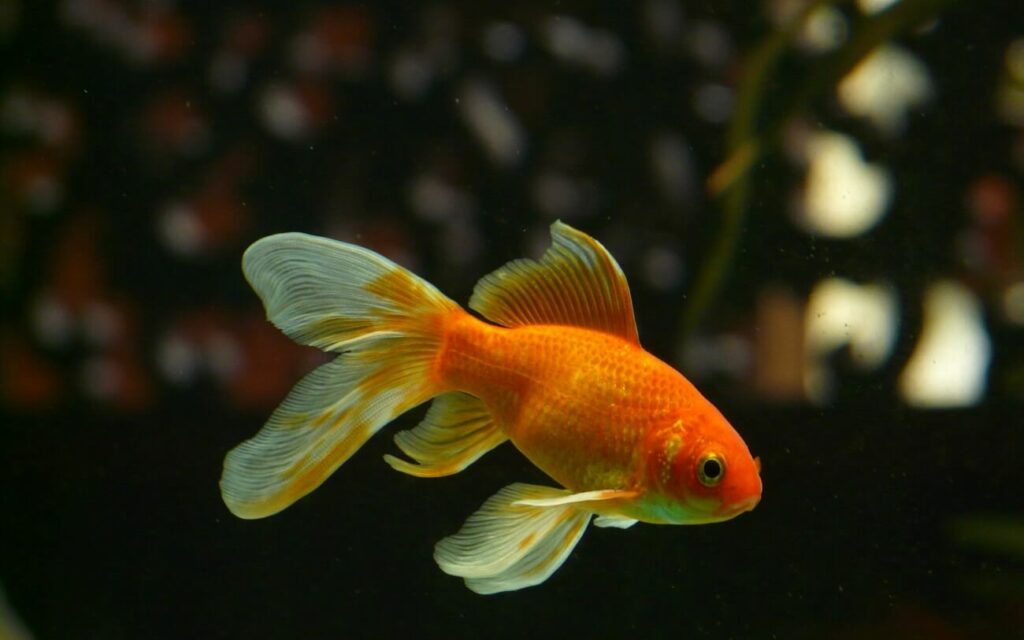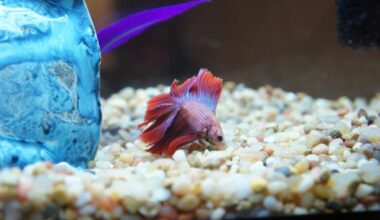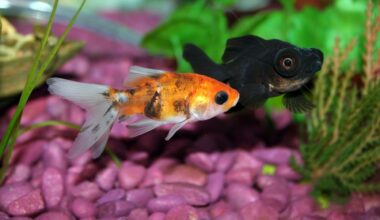The lifespan of a Goldfish can vary more than almost anything else in the aquarium scene. For such a common fish, the answer to “how long do Goldfish live” is actually quite complicated!
But this guide will clear everything up.
You’ll be able to quickly find out how long Goldfish live (in case you’re just curious), but you’ll also learn what factors influence their life expectancy!
You see, it’s important to know why some Goldfish live longer than others if you want to provide them with the best possible care. This is a situation where the solution to the riddle is also your roadmap to success.
Let’s get started.
Table of Contents
What Is The Maximum Lifespan Of A Goldfish?
Goldfish have the potential to live a very long time in the right conditions. There’s no exact maximum life expectancy, as it varies between the several Goldfish species.
That said, we can use the history of this fish to get a better idea of its potential lifespan.
Goldfish are one of the oldest domesticated fish species in history. Records of its existence date back more than 1,000 years! More modern accounts show breeders creating new species as far back as the 1600s.

Historians believe that the Goldfish was created through selective breeding of wild carp. Goldfish are part of the carp family and are closely related to Common carp (which have very long lifespans).
As a result, the maximum Goldfish lifespan can be up to 20 years when kept in the right conditions.
Of course, there are always outliers. The oldest Goldfish ever recorded died at the age of 43 years old!
So while it’s rare for a Goldfish to live past 20 years of age, it’s certainly possible. If you provide them with great care and keep them in excellent conditions, you’ll probably have them for quite a while!
How Long Do They Usually Live Instead?
If you’re surprised to find out that Goldfish can live for two decades, you’re not alone. Most people assume that these fish are temporary pets with a short life expectancy.
With their wide availability, low cost, and history of being used as prizes at the carnival, there’s a lot of misinformation about how long Goldfish live.
While we’d like to say that most Goldfish can reach that 20-year lifespan without any issues, most do not. The vast majority of Goldfish in captivity don’t even get close to the 20-year mark.
Author Note: This is due to the prevalence of poor breeding practices and insufficient care by many of the people who buy them.
In fact, the average lifespan for a common Goldfish tends to be closer to four or five years. Some may live up to ten years, but that’s only possible with optimal living conditions.
Common Goldfish vs. Fancy Goldfish Lifespan
While Common Goldfish and Fancy Goldfish still belong to the same family, they are very different.
And this impacts their lifespan as well
Fancy Goldfish species are known for their long flowing fins. Many of them have double fins, which hampers their ability to swim fast like a Common Goldfish.
Not only that, but many species have bulkier bodies. Due to so much selective breeding, these fish have developed round bodies that are more prone to disease (like dropsy).

In poor living conditions, Fancy Goldfish have a much higher risk of suffering from a disease. For super modified species, such as the Bubble Eye and Ranchu, health issues are very widespread.
Those species often only live for about five years.
In general, Fancy Goldfish are far less hardy than Common Goldfish. They’re more sensitive to changes in water quality, which can lead to a host of problems for those who are less-than-dedicated to maintaining the tank.
Common Goldfish are bred to live between 12 and 14 years. But that’s only achievable with pristine care.
Ways To Increase Their Lifespan
Just because Goldfish have a reputation for living shorter lives doesn’t mean that you have to treat them as temporary pets. Goldfish are fully capable of living long lives.
Like any other captive fish, their lifespan depends on the quality of care that you provide. In optimal living conditions, your Goldfish can thrive for many years to come.
Here are some ways that you can help your Goldfish live as long as possible.
1. Don’t Keep Them In A Bowl
The first thing you should do is keep them out of a fishbowl!
There’s nothing more iconic than the imagery of a single Goldfish in a glass bowl. Unfortunately, that tiny confined space isn’t doing your fish any favors.
For one, a fishbowl doesn’t hold much water. Most will only hold about three gallons. Goldfish need far more space than that. Some types of Goldfish can reach lengths of around 10 inches.
When they’re kept in a small bowl, their growth and development are stunted.
Plus, the lack of swimming space can cause stress and anxiety. Goldfish need to have open waters to swim. Even those that aren’t powerful swimmers need ample room to roam.
Without it, the fish’s stress levels can skyrocket. This opens up a pandora’s box of potential diseases and health problems.
The second major issue with fishbowls is the lack of proper filtration. Goldfish are messy creatures that produce a considerable amount of waste.
Without the proper filtration that comes with an established tank, ammonia and nitrate levels can increase dramatically. This can lead to ammonia poisoning, even more stress, and premature death.
Author Note: A Goldfish living in a bowl is lucky to make it to one year. Even if you do things right and perform frequent water changes, the average lifespan in a bowl is only two to three years.
2. Keep Them In A Tank That’s Large Enough
We know that fishbowls are bad, so how big of a tank does a Goldfish really need? At the very least, you should be keeping this fish in aquariums that can hold 20 gallons in order to maximize their lifespan.
A tank that’s 20 gallons or larger provides a number of benefits. For one, your fish will have plenty of room to swim and explore. The extra space can do a lot to keep your Goldfish stimulates and happy.
Secondly, larger tanks are easier to maintain water conditions. With even standard filtration equipment, the water is more likely to be well-cycled and highly oxygenated.
Author Note: Goldfish do best when added to a tank that has cycled for at least three weeks. During that time, beneficial bacteria colonies are able to grow and flourish.
Those bacteria are responsible for breaking down waste keeping ammonia levels low. When you have to constantly replace the water in a small fishbowl, that bacteria aren’t able to get established in the tank. Thus, ammonia problems are common.
It’s still possible to have quality issues in a tank. But, larger aquariums have the tools you need to keep things more stable in the long run.
3. Stay On Top Of Water Quality And Parameters
Good water quality is crucial for any fish that’s living in an aquarium. You must be proactive about maintaining the tank and keeping parameters stable.
Start by investing in a top-notch filtration system.
External hang-on-back filters or basic canister filters are more than capable of keeping the tank cycled. They’ll remove excess waste and keep water moving.
While filters do a lot of the work for you, they won’t handle everything. It’s important to clean the tank every two weeks.

This means performing partial water changes and getting rid of any algae buildup. You shouldn’t wait until the water is looking discolored or cloudy to take action.
As we mentioned earlier, Goldfish are messy. If you have a group of them, it won’t take long for waste to accumulate. Scrub the inside of the glass, utilize a gravel vacuum, and remove any leftover food.
Test the water regularly to ensure that ammonia and nitrate levels are not detectable.
In addition to the cleanliness of the tank, you must pay attention to the water parameters. Conditions can fluctuate multiple times throughout the day.
Luckily, Goldfish are hardy enough to tolerate subtle changes. It’s really the major changes that you have to worry about.
The water temperature should stay between 68°F and 74°F (these are good cold water fish). pH levels can hover between 6.8 and 7.6.
Author Note: Again, testing is key here. Check those parameters regularly and make adjustments as necessary!
4. Feed Them A Healthy Diet
Goldfish are omnivores that will eat pretty much anything that you provide. The go-to for inexperienced fish-keepers is cheap flake food. Commercial foods are great, but you need to make sure that your Goldfish is getting all the nutrients and vitamins they need.
Stick to a high-quality flake or nutritionally balanced pellet food as the staple of their diet. Then, provide some supplements to kick their diet up a notch.
Goldfish do very well when fed high-protein snacks like brine shrimp, water fleas, and tubifex worms. They also enjoy plant-based foods like blanched vegetables.
Aim for some variety when feeding the Goldfish. This will improve their overall health and provide them with some enrichment.
A good diet can even make them more colorful and vibrant than they were before!
5. Consider Keeping Them In A Pond
The absolute best thing you can do for your Goldfish is to house them in a large pond. Creating a Goldfish pond allows you to closely replicate their natural habitat, which will have a big impact on their lifespan.
Author Note: We know that this might not be a viable option for everyone based on your living situation. However, we believe it’s still important to understand why this is so beneficial!
No matter how hard you try, there’s just no way to perfectly replicate natural light and seasonal variations in an indoor aquarium. With a spacious outdoor pond, you can.
Larger ponds hold hundreds or even thousands of gallons of water. Thus, your Goldfish isn’t confined. They have all the space they would ever need!
Most Goldfish living in ponds will grow to massive sizes. Instead of staying a measly two or three inches, some species can reach their full potential in a pond.
The natural environment of a pond can extend the lifespan of a Goldfish dramatically. It’s not uncommon to see these fish reaching 20 years of age in such a large habitat.
You don’t have to start your Goldfish out in a pond. You can raise them in a standard 20-gallon tank to enjoy their company inside. Once they reach adulthood, you can transition them to the pond where they can live out the rest of their life.
Conclusion
As you can see, the typical Goldfish lifespan varies quite a bit. Depending on the care they receive and the breeding practices of the seller, you’re looking at a difference of up to 15 years!
But at the end of the day, if you want to own these fish as pets their lifespan shouldn’t deter you.
Goldfish have the capacity to live for a very long time when kept in the right conditions. As long as you’re prepared to do whatever you can to keep them healthy, you’ll be just fine!

